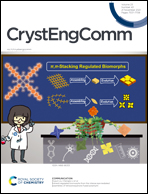A square-shaped complex with an electron-acceptor ligand: unique cubic crystal symmetry and similarity to the inorganic mineral katoite†
Abstract
Square macrocyclic complexes have attracted significant attention due to their unique structure and molecular recognition properties. Here, we report a square macrocyclic complex using an electron-acceptor ligand N,N′-di(4-pyridyl)-1,4,5,8-naphthalenediimide (dpndi), [Pt(en)(dpndi)]4(SO4)4·20H2O (1, en: ethylenediamine). The molecular structure of 1 was determined from single-crystal X-ray crystallography, and 1 is the largest Pt square (side: 2.6 nm) whose structure was crystallographically determined. Electrochemical study revealed that 1 can accept eight electrons per square unit. In 1, multiple interactions (hydrogen bonding and lone pair⋯π interactions) among the square units were observed in the solid state. This is in sharp contrast to the previous report of square macrocyclic complexes since the square–square interactions were rarely observed in these structures. The multiple square–square interactions in 1 led to the symmetrical packing of the square units and crystallization in a unique cubic crystal symmetry. Moreover, the packing structure of 1 showed a strong similarity to the high-pressure phase of the natural mineral katoite.

- This article is part of the themed collection: Supramolecular & Polymorphism


 Please wait while we load your content...
Please wait while we load your content...